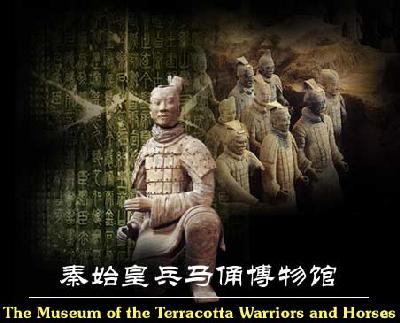|
The world-famous Qin Terra Cotta Army Museum is a site museum in China. Built on the site of the terra-cotta warriors and horses pits in the Emperor Qin's Mausoleum, the museum is located at the northern piedmont of Lishan Mountain 7.5 kilometers east of Lingtong County in Shaanxi Province and 37.5 kilometers west of Xi'an City.

In March 1974, a group of peasants digging a well made what was to become the greatest archaeological find of the 20th century when they unearthed fragments of a life-sized Terra Cotta Warrior. Excavation of the vault revealed thousands of terra-cotta warriors and their horses, an entire army designed to follow its emperor into eternity. The emperor's terra cotta army was found in three underground timber lined vaults.
The museum, a hangar-like building constructed over Pit 1, place of the original discovery in 1974, was opened to the public in 1979. The exhibition hall of Pit 3 was built in 1987 and opened to the public in 1989. Later in October 1994, Pit 2 was opened to the public. Three main buildings of the museum, which were named Pit 1, Pit 2 and Pit 3, were constructed on their original sites.
The museum covers an area of 190,000 square meters. Among all, Pit 1 has an area of 14,000 square meters for exhibition halls and Pit 3, 1,200 square meters, and the exhibition hall of copper vehicles and horses and the auxiliary exhibition hall cover over 600 square meters each.
Pit 1 contained chariots and ranks of six thousand soldiers. Pit 2 held fourteen hundred figures of cavalrymen, horses and infantrymen, along with ninety wooden chariots. Pit 3 contained about seventy figures. Excavating them has been a massive undertaking. To date, more than a thousand warriors have been reassembled.
The multiple exhibition halls lies to the east of Pit 2, covering a series of exhibits, such as two sets of bronze chariots and horses, the new findings from the Emperor Qin's Mausoleum, the history of the museum and all kinds of temporary exhibits. These displays systematically depict the history of the Qin Dynasty (221-206 BC) and can help the viewers to have a better understanding on the terra-cotta warriors and horses. The south of Pit 1 is a circle vision hall. The movie inside lasts 20 minutes and provides vivid materials for telling the story of Emperor Qin and his Terra-cotta Army 2,200 years ago. The halls on the northwest of Pit 3, which covers 4,282 square meters, are the multiple service halls where the visitors can have meal, do shopping and take a rest.
The museum is not only a treasure house, but also a main scenic spot of Xi'an city. Today the eighth wonder of the world has almost become synonym of the Terra-cotta Warriors and Horses in 1987; the Emperor Qin's Mausoleum was put on the list of the UNESCO as a world-class cultural heritage site. Now the museum is widely known as a huge modern site museum and it is going to be one of the best in the world.
|

